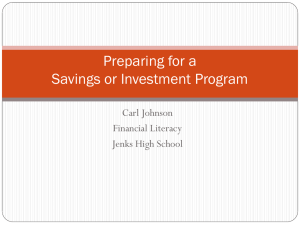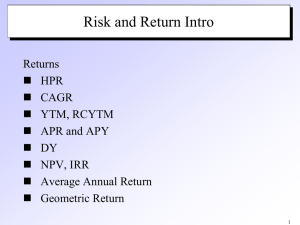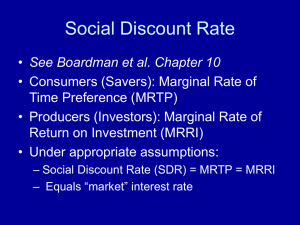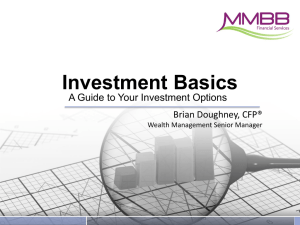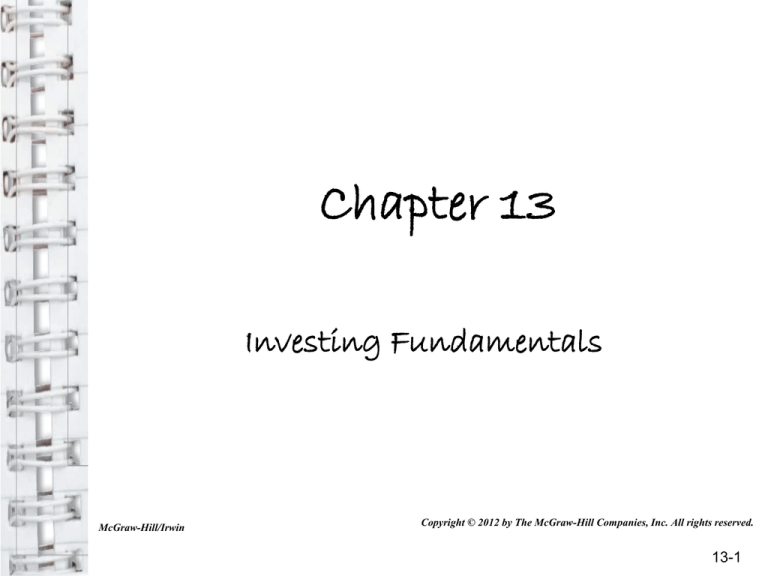
Chapter 13
Investing Fundamentals
McGraw-Hill/Irwin
Copyright © 2012 by The McGraw-Hill Companies, Inc. All rights reserved.
13-1
Chapter 13
Learning Objectives
1. Describe why you should establish an investment
program
2. Assess how safety, risk, income, growth and liquidity
affect your investment decisions
3. Explain how asset allocation and different
investments alternatives affect your investment plan
4. Recognize the importance of your role in a personal
investment program
5. Use various sources of financial information that can
reduce risks and increase investment returns
13-2
Preparing for an Investment
Program
Objective 1: Describe why you should establish an
investment program
ESTABLISHING INVESTMENT GOALS
• Financial goals should be specific and measurable.
To develop your goals ask yourself. . .
– How much will you need for your goals?
– How will you obtain the money?
– How long will it take you to obtain the money?
– How much risk are you willing to assume in an
investment program?
13-3
Preparing for an Investment
Program (continued)
ESTABLISHING INVESTMENT GOALS (continued)
– What possible economic or personal conditions
could alter your investment goals?
– Are you willing to make the sacrifices necessary to
meet your investment goals?
– What will the consequences be if you don’t reach
your investment goals?
– Given your economic circumstances, are your
investment goals reasonable?
13-4
Preparing for an Investment
Program (continued)
PERFORMING A FINANCIAL CHECKUP
• Work to balance your budget
– Do you regularly spend more than you make?
• Pay off high interest credit card debt first
• Start an emergency fund you can access quickly
– Three to nine months of living expenses
• Have access to other sources of cash for
emergencies
– Line of credit is a short-term loan approved before
the money is needed
– Cash advance on your credit card
13-5
Preparing for an Investment
Program (continued)
8 steps to managing a financial crisis
1.
2.
3.
4.
5.
6.
Establish a larger than usual emergency fund
Know what you owe
Reduce spending
Pay off credit cards
Apply for a line of credit
Notify credit companies and lenders if you are unable
to make a payments
7. Monitor the value of your investment and retirement
accounts
8. Consider converting investments to cash to preserve
value
13-6
Preparing for an Investment
Program (continued)
GETTING THE MONEY NEEDED TO START AN
INVESTMENT PROGRAM
• How badly do you want to achieve your investment
•
•
•
•
goals?
Are you willing to sacrifice some purchases to provide
financing for your investments?
What do you value?
Participate in elective savings programs
– Payroll deduction or electronic transfer
Make extra effort to save one or two months each
year
13-7
Factors Affecting the
Choice of Investments
Objective 2: Assess how safety, risk, income,
growth, and liquidity affect your investment
decisions
• Safety and risk
– Safety in any investment means minimal risk of
loss
– Risk means a measure of uncertainty about the
outcome
– Investments range from very safe to very risky
– The potential return on any investment should be
directly related to the risk the investor assumes
– Speculative investments are high risk
13-8
Safety and Risk
• The Risk-Return Trade-Off
– Choosing higher risk investments, investors expect higher
returns
13-9
Factors Affecting the
Choice of Investments
• Risk Tolerance
• Calculating Rate of Return
– Subtract the investment’s initial value from the investment’s
ending value
– Add the investment income to the amount calculated above
– Divide the net investment income and change in value by the
investment’s initial value
13-10
Factors Affecting the
Choice of Investments (continued)
COMPONENTS OF THE RISK FACTOR
• Inflation risk - during periods of high inflation your
investment return may not keep pace with the inflation
rate
• Interest rate risk - you may invest in a bond at a 6%,
rates later go up to 8%; your bond price falls
13-11
Factors Affecting the
Choice of Investments (continued)
COMPONENTS OF THE RISK FACTOR (continued)
• Business failure risk - bad management or products
affect stocks, municipal or corporate bonds and mutual
funds that invest in stock
• Market risk - prices fluctuate because of behaviors of
investors
• Global investment risk - changes in currency affect
the return on your investment
13-12
Factors Affecting the
Choice of Investments (continued)
INVESTMENT INCOME
• Safest investments – predictable income
– Savings accounts and certificates of deposit
– U.S. savings bonds
– United States treasury bills
13-13
Factors Affecting the
Choice of Investments (continued)
INVESTMENT INCOME (continued)
• Higher potential income investments include…
– Municipal bonds
– Corporate bonds
– Preferred stocks and income common stocks
– Income mutual funds
– Real estate rental property
13-14
Factors Affecting the
Choice of Investments (continued)
INVESTMENT GROWTH
• Growth means investment will increase in value
– Common stock
– Growth companies pay little or no dividends, but
reinvest in the company
– Mutual funds, government and corporate bonds,
and real estate offer growth potential
• INVESTMENT LIQUIDITY
– Ability to buy or sell an investment quickly without
substantially affecting the investment’s value; e.g.
Real estate is not a very liquid investment
13-15
Asset Allocation and Investment
Alternatives
Objective 3: Explain how asset allocation and
different investment alternatives affect your
investment plan
– Asset Allocation
• The process of placing your assets among several
types of investments which lessens your investment
risk
– Time Factor
• The longer that you are invested the better your
opportunity for increasing returns
– Your Age
• The type and style of your investments should change
with your age
13-16
Asset Allocation and Investment
Alternatives (contined)
Stock or equity financing
– Equity capital is provided by stockholders who
–
–
–
–
buy shares of a company’s stock.
Stockholders are owners and share in the
success of the company.
A corporation is not required to repay the money
obtained from the sale of stock.
The corporation is under no legal obligation to
pay dividends to stockholders: they may instead
retain all or part of earnings.
Two basic types of stock
• Common stock
• Preferred stock
13-17
Asset Allocation and Investment
Alternatives (continued)
CORPORATE AND GOVERNMENT BONDS
• A bond is a loan to a corporation, the federal
government, or a municipality
• Bondholders receive periodic interest payments, and
the principal is repaid at maturity (1-30 years)
• Bondholders can keep the bond until maturity or sell
it to another investor before maturity
13-18
Asset Allocation and Investment
Alternatives (continued)
• Mutual funds
– Investors’ money is pooled and invested by a
professional fund manager
– You buy shares in the fund
– Provides diversification to reduce risk
– Funds range from conservative to extremely
speculative
– Match your needs with a fund’s objective
– Be aware of fees depending upon different fund
chosen
13-19
Asset Allocation and Investment
Alternatives (continued)
REAL ESTATE
• The goal of a real estate investment is to buy a
property and sell it at a profit. Nationally, 3%
appreciation in price a year is average. However,
decreases in value are also possible.
• Location, location, location is important.
13-20
Asset Allocation and Investment
Alternatives (continued)
• Before you buy real estate...
1. Is the property priced competitively?
2. What type, if any, of financing is available?
3. How much are the taxes?
4. What is the condition of the buildings and houses
in the immediate area?
5. Why are the present owners selling?
6. Could the property decrease in value?
13-21
Asset Allocation and Investment
Alternatives (continued)
OTHER SPECULATIVE INVESTMENTS
• Speculative investments
– A speculative investment is a high-risk investment
made in the hope of earning a relatively large profit
in a short time Typical speculative investments
include:
• Antiques and collectibles
• Call and put options
• Derivatives
• Commodities
• Coins and stamps
• Precious metals and gemstones
13-22
A Personal Plan for Investing
1. Establish realistic goals
2. Determine the amount of money needed to meet
your goals
3. Specify the amount of money available to fund
your investments
4. List different investments you want to evaluate
5. Evaluate risk and potential return for each
6. Reduce possible investments to a reasonable
number
7. Choose at least two different investments
8. Continue to evaluate your investment program
13-23
Factors that Reduce Investment Risk
Objective 4: Recognize the importance of
your role in a personal investment program
YOUR ROLE IN THE INVESTMENT PROCESS
• Evaluate potential investments
• Monitor the value of your investments
• Keep accurate and current records
• Seek the assistance of a financial planner
– (see Appendix at the back of the text)
• Consider the tax consequences of selling your
investments
13-24
Sources of Investment Information
Objective 5: Use the various sources of financial
information that can reduce risks and increase
the investment returns
• The Internet
– A wealth of investment information is available
– View sites such as www.yahoo.com, www.fool.com,
and www.money.cnn.com
• Newspapers and news programs
• Business periodicals such as Smart Money and
government publications
• Corporate Reports
• Investor services and newsletters, such as ValueLine
or Morningstar and financial calculators
13-25




